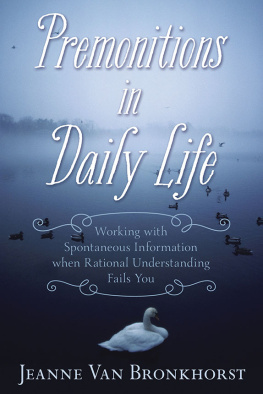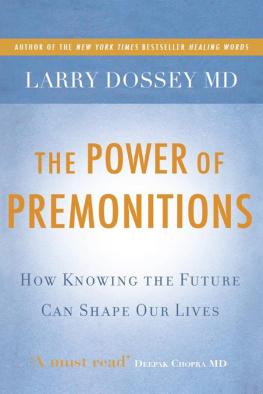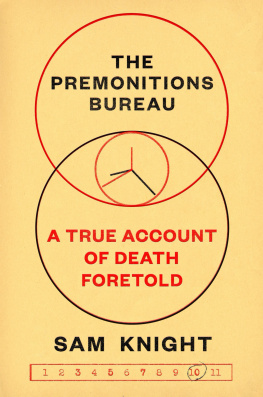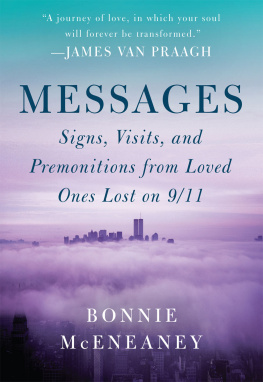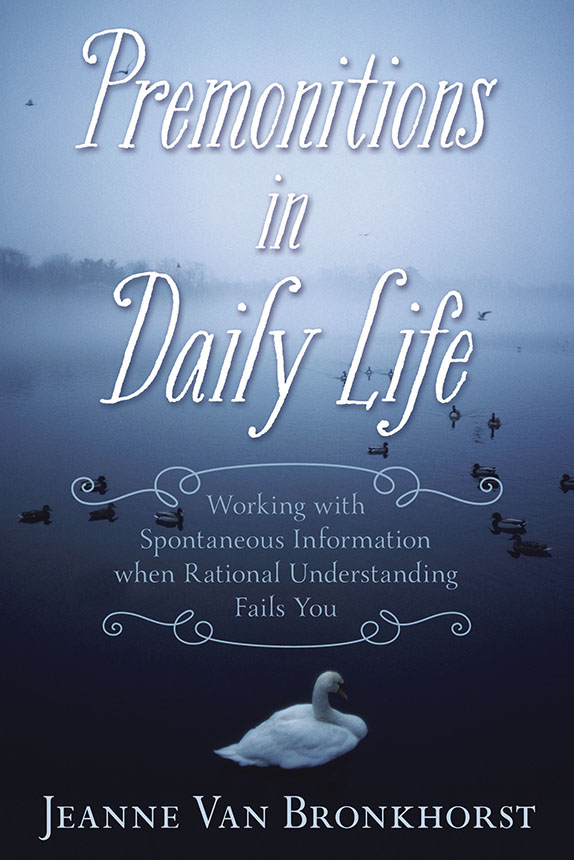Jeanne Van Bronkhorst experienced her first premonition at the age of five, and since then has had premonitions often enough to both trust their warnings and appreciate the questions they raise about free will, destiny, and the ways memory and imagination weave together. Those questions led her to graduate work in psychology and then social work, and a career in hospice social work. For the past twenty years she has helped people who face life-threatening illnesses.
She has given many lectures and workshops to healthcare professionals and hospice volunteers on topics related to bereavement and HIV/AIDS. She is a member of the International Organization for Noetic Sciences and of the International Association for the Study of Dreams. A native of Seattle, Washington, she now lives and works in Toronto, Ontario.

Llewellyn Publications
Woodbury, Minnesota
Copyright Information
Premonitions in Daily Life: Working with Spontaneous Information When Rational Understanding Fails You 2013 by Jeanne Van Bronkhorst.
All rights reserved. No part of this book may be used or reproduced in any matter whatsoever, including Internet usage, without written permission from Llewellyn Publications, except in the form of brief quotations embodied in critical articles and reviews.
As the purchaser of this e-book, you are granted the non-exclusive, non-transferable right to access and read the text of this e-book on screen. The text may not be otherwise reproduced, transmitted, downloaded, or recorded on any other storage device in any form or by any means.
Any unauthorized usage of the text without express written permission of the publisher is a violation of the authors copyright and is illegal and punishable by law.
First e-book edition 2013
E-book ISBN: 9780738735221
Book design by Donna Burch
Cover art: Swan: Fancy Collection/SuperStock
Cover design by Lisa Novak
Editing by Connie Hill
Llewellyn Publications is an imprint of Llewellyn Worldwide Ltd.
Llewellyn Publications does not participate in, endorse, or have any authority or responsibility concerning private business arrangements between our authors and the public.
Any Internet references contained in this work are current at publication time, but the publisher cannot guarantee that a specific reference will continue or be maintained. Please refer to the publishers website for links to current author websites.
Llewellyn Publications
Llewellyn Worldwide Ltd.
2143 Wooddale Drive
Woodbury, MN 55125
www.llewellyn.com
Manufactured in the United States of America
To Ann, my home, who makes all things possible
Contents
: What Would You Do?
Part One: Inside a Premonition
: How to Recognize a Premonition
: Exploring Ordinary Premonitions on Your Own
: What Else Could It Be? Questions You Can Ask Yourself
Part Two: Common Assumptions
: Memory, Imagination, and Free Will
: Proof in Daily Life
: Premonitions in Popular Culture
Part Three: Meaning of Premonitions
: But What Does It Mean? Making Sense of Premonitions
: What Does It Say About Me? Premonitions and Self-Identity
: What Do I Do Now? How to Respond to a Premonition
: Who Can I Tell? Finding Community
: The Stories We Tell
: Putting the Psi in Science
: How to Approach Premonitions in a Clinical Setting
: Reading On
Acknowledgments
My heartfelt thanks to Susan Simmons, my good friend and brilliant editor. You alternately encouraged and challenged me, and taught me how to write for an audience larger than one person. This comma , is for you!
Many thanks to Charlie, Evelyn, Julie, Olivia, Phillip, and Roger, who took a chance in sharing their stories. Your warmth, humor, and many insights offer us a glimpse into the twisting, complex, splendid dance between memory and imagination in time.
I am grateful to Angela Wix, acquisition editor, and the Llewellyn staff for discovering and championing my book. I am grateful as well for the dedicated and passionate writers at the Canadian Authors Association, whose encouragement helped me hang in there, keep writing, and find a publisher.
And finally, my warm thanks to B. Alford for offering me a caring and honest appraisal of my first draft, may it rest in peace. Such friendships are rare and to be treasured.
INTRODUCTION

What Would You Do?
Imagine you are sitting in an airplane, dozing over the in-flight magazine as other passengers jostle past to their seats. All around are muted conversations, the soft clicking of overhead compartments being shut, engines idling. But as the plane backs away from the terminal, you wake with a start. In your minds eye you see one of the wheels wobble and fall away as the plane rushes down the runway, and you know the plane will skid and slide off the runway before it finally stops, with passengers and crewincluding youshaken and frightened.
What would you do?
Most people understand that fear of flying happens at any time. Even seasoned travelers know they will have occasional moments of anxiety, and they treat those moments as just thatanxious thoughts that have nothing to do with the actual flight. They push the feeling away, calm themselves with safety statistics, and settle back into their seats.
But if you are reading this book you also know another possibility exists. This sudden worry just might be a premonition, and that possibility brings up questions most people have not considered. What bit of information lets you know this is a warning of imminent danger and not just anxiety in a new form? If you decide your vision is a genuine premonition, what do you do next? Do you notify the pilot, force your way off the plane, warn others to get off the plane with you? Or do you quietly prepare yourself for a frightening but ultimately non-lethal accident? If you trust the warning, can you trust the limited nature of the accident you just pictured? What do you do with an intense and disturbing experience that has no good explanation?
Most people in modern Western culture have been taught that premonitions are not real. Premonitions supposedly belong to a distant past, before the Age of Enlightenment, back when superstitions and magical thinking drove peoples imaginations and beliefs. We have been taught premonitions belong to a pre-rational, pre-scientific time, and we are best off when we keep them safely back there.
It does seem that premonitions challenge everything this culture teaches about the forward direction of time, the law of cause and effect, free will, even what God has intended for us. Many people ask why they should throw away everything they already know about the world for such a rare, fleeting, random event that might never repeat itself.
The Problem with Premonitions
The problem with premonitions is not their rarity. Research has shown premonitions can happen to anyone: men and women, children and adults, scientists and artists, waiters, farmers, police officers, nurses and teachers, business consultants, students, engineers, and ministers, regardless of their personal comfort with them. Most people I know can tell at least one story of a moment in which someonemaybe a friend, maybe themselvesseemed to know what was going to happen before they should have known it.

